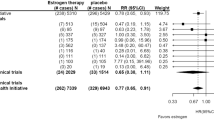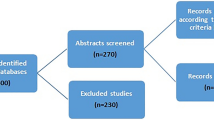Abstract
Objective
The aim of this study is to investigate the association between breast cancer and serum selenium level as well as other risk factors for breast cancer.
Methods
A matched case-control study was conducted in a hospital in Malaysia from July 2000 to January 2001 and from May 2001 to June 2001. Sixty-two newly diagnosed breast cancer patients were selected as the cases. Each control, selected from the same hospital population was matched to each case according to age, ethnic group, and menopausal status.
Results
The mean selenium concentration among the cases was significantly lower than that among the control. There was a significant association (p<0.05) between breast cancer and low selenium serum level, nulliparity (OR=5.5,95% CI=1.22 to 24.81), exposure to cigarette smoke (OR=2.2, 95% CI=1.04 to 4.65) and use of oral contraceptives (OR=3.0, 95% CI=1.09 to 8.25) as determined by the McNemar test. Multivariate analysis showed that nulliparity (OR=10.08, 95% CI=1.48 to 68.52) and use of oral contraceptives (OR=3.66, 95% CI=1.36 to 9.87) were associated with increased breast cancer risk. An increased selenium concentration contributes to a reduced risk of breast cancer (OR=0.89, 95% CI=0.84 to 0.94).
Conclusion
The results suggest that use of oral contraceptive pills, being nulliparous, and a low serum selenium level are associated with breast cancer.
Similar content being viewed by others
References
Parkin DM, Bray FI, Devesa SS. Cancer burden in the year 2000: The global picture. Eur J Cancer. 2001;37:4–66.
McPherson K, Steel CM, Dixon JM. Breast cancer epidemiology, risk factors and genetics: clinical review. Br Med J. 2000;321:624–628.
Ministry of Health. National Health and Morbidity Survey Report. Ministry of Health: Kuala Lumpur, Malaysia; 1997.
Clark LC, Cantor KP, Allaway W. Selenium in forage crops and cancer mortality in US counties. Arch Env Health. 1991; 46:37–42.
Harr JR. Effect of dietary selenium onN-2-fluorenylacetamide (FAA): Induced cancer in vitamin E-supplemented selenium depleted rat. Clin Toxicol. 1972;5:187–194.
Shamberger RJ, Frost DV. Possible protective effect of selenium against human cancer. Can Med Assoc J. 1969; 104:82–84.
Shamberger RJ, Willis CE. Selenium distribution and human cancer mortality. Crit Rev Clin Lab Sci. 1971;2:211–221.
Xiu YQ, An YZ, Guang LW, Wen ZP. The association between breast cancer and other factors. Asia Pacific J Pub Health. 1994;7:98–104.
Ge K, Yang G. The epidemiology of selenium deficiency in the etiological study of endemic diseases in China. Am J Clin Nutr. 1993;57:259–263.
Hunter DJ, Morris JS, Stampher MJ, Colditz GA, Speizer FE, Willett WC. A prospective study of selenium status and breast cancer risk. J Am Med Assoc. 1990;264:1128–1131.
Madigan MP, Ziegler RG, Benichou J, Byrne C, Hoover RN. Proportion of breast cancer cases in the United States explained by well-established risk factors. J Natl Cancer Inst. 1995;87:1681–1685.
Slattery ML, Kerber RA. A comprehensive evaluation of family history and breast cancer risk. The Utah Population Database. J Am Med Assoc. 1993;270:1563–1568.
Claus EB, Risch NJ, Thompson WD. Age at onset as an indicator of familial risk of breast cancer. Am J Epidemiol. 1990;131:961–972.
Collaborative Group on Hormonal Factors in Breast Cancer. Collaborative group on hormonal factors in breast cancer: Breast cancer and hormonal contraceptives: Collaborative reanalysis of individual data on 53 297 women with breast cancer and 100 239 women without breast cancer from 54 epidemiological studies. Lancet. 1996;347: 1713–1727.
Steinberg KK, Thacker SB, Smith SJ. A meta-analysis of the effect of estrogen replacement therapy on the risk of breast cancer. J Am Med Assoc. 1991;265:1985–1990.
Tee ES. Changing dietary intake and food consumption in Malaysia. National implications. Institute for Medical Research: Kuala Lumpur, Malaysia; 1995.
Thomas CT. Methods for biological monitoring: a manual for assessing human exposure to hazardous substances. In: Kneip TJ, Crable JV editors. Washington: American Public Health Association; 1988. p. 237–240.
Amstrong K, Eisen A, Weber B. Primary care: Assessing the risk of breast cancer. N Engl J Med. 2000;342:564–571.
Cui Y, Miller AB, Rohan TE. Cigarette smoking and breast cancer risk: update of a prospective cohort study. Breast Cancer Res Treat. 2006;100:293–298.
Combs GF, Clark LC. Can dietary selenium modify cancer risk? Nutr Rev. 1985;43:325–331.
Vernie LN. Selenium in carcinogenesis. Biochim Biophys Acta. 1984;738:203–217.
Schrauzer GN, Molenaar T, Mead S, Kuehn K, Yamamoto H, Araki E. Selenium in the blood of Japanese and American women with and without breast cancer and fibrocystic disease. Jpn J Cancer Res. 1985;76:374–377.
Dupont WD, Page DL. Breast cancer risk associated with proliferative disease, age at first birth and a family history of breast cancer. Am J Epidemiol. 1987;125:769–779.
Helmrich SP, Shapiro S, Rosenberg L, Kaufman DW, Slone D, Bain C, et al. Risk factors for breast cancer. Am J Epidemiol. 1983;117:35–45.
Lipnick R, Speizer FE, Bain C, Willett W, Rosner B, Stampfer MJ, et al. A case-control study of risk indicators among women with premenopausal and early postmenopausal breast cancer. Cancer. 1984;53:1020–1024.
Soini I. Risk factors of breast cancer in Finland. Int J Epidemiol. 1977;6:365–373.
Lahmann PH, Hoffmann K, Allen N, van Gils CH, Khaw KT, Tehard B, et al. Body size and breast cancer risk: Findings from the European Prospective Investigation into Cancer And Nutrition. Int J Cancer. 2004;111:762–771.
Zhu K, Caulfield J, Hunter S, Roland CL, Payne-Wilks K, Texter L. Body mass index and breast cancer risk in African American women. Ann Epidemiol. 2005;15:123–128.
Tao MH, Shu XO, Ruan ZX, Gao YT, Zheng W. Association of overweight with breast cancer survival. Am J Epidemiol. 2006;163:101–107.
Hunter DJ, Spiegelman D, Adami H, Beeson L, van den Brandt P, Folsom AR, et al. Cohort studies of fat intake and the risk of breast cancer: A pooled analysis. N Engl J Med. 1995;334:356–361.
Collaborative group on hormonal factors in breast cancer. Breast cancer and hormonal contraceptives: Collaborative reanalysis of individual data on 53 297 women with breast cancer and 100 239 women without breast cancer from 54 epidemiological studies. Lancet. 1996;347:1713–1727.
World Health Organization. International Program on Chemical Safety. World Health Organization: Geneva, Switzerland; 1987.
Author information
Authors and Affiliations
Corresponding author
Rights and permissions
About this article
Cite this article
Rejali, L., Jaafar, M.H. & Ismail, N.H. Serum selenium level and other risk factors for breast cancer among patients in a Malaysian hospital. Environ Health Prev Med 12, 105–110 (2007). https://doi.org/10.1007/BF02898024
Received:
Accepted:
Issue Date:
DOI: https://doi.org/10.1007/BF02898024




